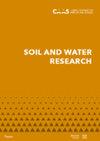球囊素——土壤有机质中一种有趣的蛋白质
IF 1.7
4区 农林科学
Q4 SOIL SCIENCE
引用次数: 27
摘要
目前农业做法的负面影响包括侵蚀、酸化、土壤有机物损失(除湿)、土壤结构损失、危险元素对土壤的污染、生物多样性减少和非农业用地。从农学的角度来看,所有这些影响都对土壤质量的进一步发展及其对预计气候变化的抵御能力构成了巨大风险。有机质在其中起着至关重要的作用。已经发现,有机质或土壤有机质的某些部分与土壤参数的质量或健康具有相对显著的相关性。特别是Ctot、Cox、腐殖酸和黄腐酸、C/N比和电气石。我们的工作重点是glomalin,一种由丛枝菌根真菌(AMF)的菌丝和孢子产生的糖蛋白,我们将其归类为Glomeromycota。丛枝菌根及其分子途径并不是一个很好理解的现象。看来许多蛋白质都与丛枝菌根有关,其中glomalin可能是最重要的一种。这种蛋白质还负责土壤独特的化学和物理特性,在这个意义上具有生态和经济相关性,它是菌根的真正产物。Glomalin非常耐破坏(顽固不化),很难溶解在水中。其提取需要特定的条件:高温(121°C)和pH为中性或碱性的柠檬酸盐缓冲液。由于这些特性,电气石(或其组分)是非常稳定的化合物,可以保护土壤骨料表面。在这篇综述中,对实际文献进行了研究,并讨论了glomalin的重要性。本文章由计算机程序翻译,如有差异,请以英文原文为准。
Glomalin – an interesting protein part of the soil organic matter
The negative effects of the current agricultural practices include erosion, acidification, loss of soil organic matter (dehumification), loss of soil structure, soil contamination by risky elements, reduction of biological diversity and land use for non-agricultural purposes. All these effects are a huge risk to the further development of soil quality from an agronomic point of view and its resilience to projected climate change. Organic matter has a crucial role in it. Relatively significant correlations with the quality or the health of soil parameters and the soil organic matter or some fraction of the soil organic matter have been found. In particular, Ctot, Cox, humic and fulvic acids, the C/N ratio, and glomalin. Our work was focused on glomalin, a glycoprotein produced by the hyphae and spores of arbuscular mycorrhizal fungi (AMF), which we classify as Glomeromycota. Arbuscular mycorrhiza, and its molecular pathways, is not a well understood phenomenon. It appears that many proteins are involved in the arbuscular mycorrhiza from which glomalin is probably one of the most significant. This protein is also responsible for the unique chemical and physical properties of soils and has an ecological and economical relevance in this sense and it is a real product of the mycorrhiza. Glomalin is very resistant to destruction (recalcitrant) and difficult to dissolve in water. Its extraction requires specific conditions: high temperature (121°C) and a citrate buffer with a neutral or alkaline pH. Due to these properties, glomalin (or its fractions) are very stable compounds that protect the soil aggregate surface. In this review, the actual literature has been researched and the importance of glomalin is discussed.
求助全文
通过发布文献求助,成功后即可免费获取论文全文。
去求助
来源期刊

Soil and Water Research
Water resources, Soil Science, Agriculture-WATER RESOURCES
CiteScore
4.60
自引率
0.00%
发文量
26
审稿时长
>12 weeks
期刊介绍:
An international peer-reviewed journal published under the auspices of the Czech Academy of Agricultural Sciences and financed by the Ministry of Agriculture of the Czech Republic. Published since 2006.
Thematic: original papers, short communications and critical reviews from all fields of science and engineering related to soil and water and their interactions in natural and man-modified landscapes, with a particular focus on agricultural land use. The fields encompassed include, but are not limited to, the basic and applied soil science, soil hydrology, irrigation and drainage of lands, hydrology, management and revitalisation of small water streams and small water reservoirs, including fishponds, soil erosion research and control, drought and flood control, wetland restoration and protection, surface and ground water protection in therms of their quantity and quality.
 求助内容:
求助内容: 应助结果提醒方式:
应助结果提醒方式:


